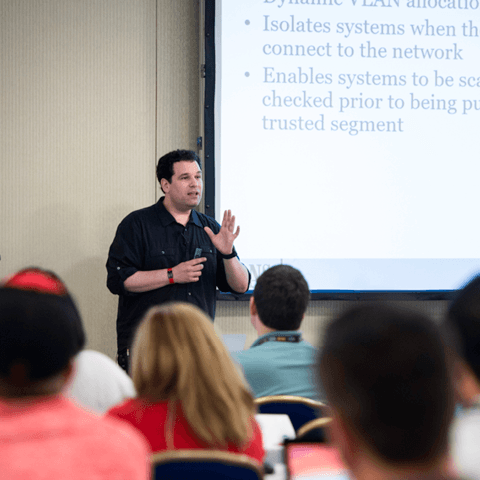SEC595: Applied Data Science and AI/Machine Learning for Cybersecurity Professionals


Experience SANS training through course previews.
Learn MoreLet us help.
Contact usBecome a member for instant access to our free resources.
Sign UpWe're here to help.
Contact Us
Apply your credits to renew your certifications
Attend a live, instructor-led class at a location near you or remotely, or train on your time over 4 months
Course material is geared for cyber security professionals with hands-on experience
Apply what you learn with hands-on exercises and labs
This course offers an MBA-level approach, preparing cybersecurity leaders to build strategic plans, craft effective policies, and lead across technical and business teams.
This course is a cyber leadership MBA in five days. As a security manager of many years, the class delivered material of great value that I can immediately apply to make a difference at my company.
Forge the crucial bridge between technical security teams and executive management through strategic planning and program development. This course equips security professionals with essential tools to create comprehensive cybersecurity strategy, develop sound security policies, and lead implementation teams effectively. Whether you’re seeking to elevate your leadership impact or prepare for the GSTRT certification (GIAC Strategic Planning, Policy, and Leadership), LDR514 delivers practical skills and executive-level insight.
Through this immersive experience, participants prepare executive presentations, analyze business case studies, address challenges faced by fictional organizations, and engage with 20 Cyber42 leadership simulation challenges. The course also utilizes 9 real-world scenarios and 3 in-depth business case studies to cultivate critical thinking and practical application.
Security leaders will develop the ability to implement strategic approaches aligned with organizational objectives and communicate security imperatives persuasively to business executives— skills that are essential for anyone pursuing a mature cyber security strategy or preparing for the GSTRT certification.


Frank Kim is the Founder of ThinkSec, a security consulting and CISO advisory firm. He leads the Cybersecurity Leadership and Cloud Security curricula at SANS, as well as authors and instructs multiple SANS courses.
Read more about Frank KimExplore the course syllabus below to view the full range of topics covered in LDR514: Security Strategic Planning, Policy, and Leadership.
Students learn frameworks for developing strategic plans that connect security to business and organizational drivers. This section examines stakeholder identification and ways to gain executive support. Through exercises including capability assessments, roadmap development, and strategy maps, students practice creating plans that gain executive approval.
Section two establishes methodologies for analyzing security posture, identifying target states, and developing prioritized roadmaps. Students learn to assess organizational vision, conduct SWOT analysis, and apply security frameworks. The section covers business case creation and metrics for effectively marketing security initiatives.
Section three explores policy as a security leadership tool for guiding organizational behavior. Participants learn methods for developing policies aligned with corporate culture. The section covers policy lifecycle from creation to measurement, with a focus on governance and emerging technology considerations.
Section four addresses critical skills for leading, motivating, and inspiring security teams. Participants develop knowledge and abilities essential for transitioning from management to leadership. The section establishes standards for effective leadership and explores methods for employee motivation aligned with organizational goals.
Section five applies course concepts through Harvard Business School case studies focused on information security leadership. Participants analyze real-world scenarios that reinforce management competencies. The Strategic Planning Workshop serves as a capstone exercise where students synthesize methodologies and tools from previous sections.
Manages compliance with cybersecurity-related standards, legal and regulatory frameworks based on the organisation’s strategy and legal requirements.
Explore learning pathResponsible for overseeing and directly managing technology projects. Ensures cybersecurity is built into projects to protect the organization’s critical infrastructure and assets, reduce risk, and meet organizational goals. Tracks and communicates project status and demonstrates project value to the organization.
Explore learning pathResponsible for managing the cybersecurity of a program, organization, system, or enclave.
Explore learning pathDaily focus is on the oversight of technical teams while aligning them to overall business strategies. Includes titles such as Technical Director, Information Security Officer, and CISO.
Explore learning pathManage the organisation's cybersecurity-related risks aligned to the organisation’s strategy. Develop, maintain and communicate the risk management processes and reports.
Explore learning pathAlign technology, business strategy, and people.
Explore learning pathThis role conducts supervises, manages and leads cybersecurity teams and work. Find the SANS courses that map to the Leadership SCyWF Work Role.
Explore learning pathSets direction and policies for cyber operations, assumes risk decisions, and aligns mission objectives with available cyber resources.
Explore learning pathAdd a GIAC certification attempt and receive free two practice tests. View pricing in the info icons below.
When purchasing a live instructor-led class, add an additional 4 months of online access after your course. View pricing in the info icons below.
I love the lab and exercises. They are exactly what I am looking for as the new Marketplace Security PM on my team.
I have truly enjoyed the labs and exercises. They have broken up the course throughout the week. There has been a lot of information, but these exercises and labs helped us to put the knowledge into action.
SANS provides the absolute best training material. I'm ready to roll up my sleeves and implement what I’ve learned this week, which was challenging and made me think how I approach leadership and security strategy.
This course is a game changer for me. It has been very timely and inspirational at this point in my career. All of the tools reviewed in this course are applicable to program goals I am working on RIGHT NOW! Very useful!

Get feedback from the world’s best cybersecurity experts and instructors

Choose how you want to learn - online, on demand, or at our live in-person training events

Get access to our range of industry-leading courses and resources